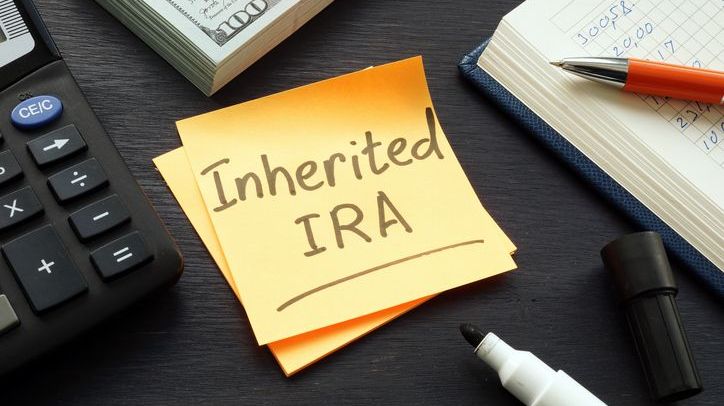If you inherit a tax-deferred retirement account, like an IRA or a 401(k), you’ll pay income taxes on the money when you withdraw it. Those withdrawals are subject to your marginal tax rate, not the original owners. This can reduce the value of your inheritance, potentially by quite a lot if you are in a high tax bracket.
For example, say that you’re in the 32% tax bracket and you’ve just inherited an IRA worth $550,000. This is a substantial windfall, but the IRS is going to take a significant amount of each withdrawal. A financial advisor can help you manage your inheritance and potentially mitigate the taxes due on this income.
What Are IRA Inheritance Rules?
When you inherit a pre-tax account, like an IRA, the IRS has specific rules for how the account must be managed depending on your relationship to the deceased.
While spouses typically have greater flexibility for how and when they must empty the inherited account, most non-spouse beneficiaries must empty the account within 10 years if the original owner died after Jan. 1, 2020.
Exceptions to this 10-year rule apply to heirs who are considered “eligible designated beneficiaries,” which includes:
- Minor children
- Disabled or chronically ill individuals
- Individuals who are not more than 10 years younger than the deceased
All other non-spousal heirs, like adult children (except entities like charities and some trusts), are considered “designated beneficiaries.” They must follow the 10-year rule (or the equivalent 5-year rule if the owner died before 2020). This means that the heir must withdraw all of an IRA’s assets by Dec. 31 of the year containing the 10th anniversary of the original owner’s death. These withdrawals are not subject to early withdrawal penalties.
If the owner had already begun taking RMDs, known as dying after the “required beginning date” (RBD), then you must also take minimum distributions while you hold the IRA. You determine this RMD using the longer of either your or the original owner’s life expectancy table. Keep in mind that if RMDs apply, you’re still required to empty the account within 10 years.
A financial advisor can help you manage an inherited IRA and ensure you follow the proper rules for withdrawing money from it.
How to Manage Taxes on an Inherited IRA

Let’s say you inherit $550,000 in an IRA from your dad in 2025 and that he died prior to reaching his RBD. You’re considered a “designated beneficiary” (meaning you are not a spouse, a minor child or are disabled), you typically have two general options for emptying the account:
- Take a lump sum withdrawal at some point in the next 10 years
- Take staggered withdrawals over the next 10 years
You cannot transfer this money into a Roth or traditional IRA that you own. However, if you inherited another IRA or Roth IRA, you can roll the money into that account. The significance to this rule is that it limits you only to accounts to which you cannot add new funds.
Here, say that you’re in the 32% tax bracket. As a single person, that means your income ranges between $197,300 and $250,525. Unless you can adjust your income year-to-year – typically not an option for salaried households – every dollar you take from the IRA will be taxed at no less than 32%.
From there, you have a few options:
Plan Around a Financial Event
If you have a significant, income-adjusting life event on the horizon, you can keep this money in place until then. For example, say that you intend to start a new business or retire within the next 10 years. You could leave the IRA in place, then take your withdrawals once your income has dropped as a result of the life event.
This is an edge case, to be sure, but potentially worth taking advantage of if possible.
Take a Lump-Sum Distribution
Say that you’re near the middle of the 32% bracket, earning about $217,837 per year. If you take all $550,000 out in one lump sum, you will pay roughly $191,520 in taxes on this withdrawal. This would leave you with $358,880 to invest as you see fit. This puts most of your withdrawal in the higher, 35%, tax bracket.
Take Staggered Distributions
The alternative to a lump-sum distribution is a staggered distribution.
For example, say that you are at the bottom of the 32% tax bracket making $198,000 per year. You could take out $55,000 per year for the next 10 years and pay 32% on almost all of that. This withdrawal would push your income to $253,000, meaning that only about $2,475 of your IRA distribution would be taxed at 35%. The rest would be taxed at 32%.
Absent an income event, this may be your best option for minimizing the taxes on your IRA withdrawals. By keeping almost all of your withdrawals under the highest tax bracket, you will pay just over $17,674 per year in taxes on each $55,000 withdrawal.
This will come to $176,743 in total withdrawal taxes, a meaningful saving compared with the taxes you would pay in one lump sum. You could save about $15,000 in taxes by withdrawing this money in stages, which is money that you could then reinvest.
Keep in mind that a financial advisor can help you stagger your distributions to keep your taxable income within your current tax bracket.
Bottom Line

When you inherit an IRA, a couple of rules apply. For most non-spousal heirs, you must withdraw the money within 10 years and you can’t contribute new assets to the account. And when you do take out the money, you will owe income taxes on all of it. You can manage those withdrawal taxes, but make sure to pay attention to the tax status of the assets themselves when you do so.
Tips for Passing Down Your Retirement Accounts
- If you’re planning for your estate, there’s some good news: You can help your heirs avoid the hassle of paying taxes on their inheritances. A mid-retirement Roth conversion isn’t usually useful for income planning, but there are estate planning benefits, including tax-free income for your heirs.
- A financial advisor can help you build a comprehensive retirement plan. Finding a financial advisor doesn’t have to be hard. SmartAsset’s free tool matches you with up to three vetted financial advisors who serve your area, and you can have a free introductory call with your advisor matches to decide which one you feel is right for you. If you’re ready to find an advisor who can help you achieve your financial goals, get started now.
Photo credit: ©iStock.com/Djordje Djeric, ©iStock.com/designer491, ©iStock.com/Moyo Studio
